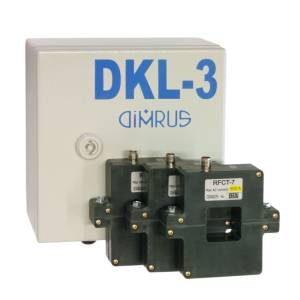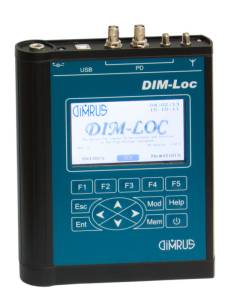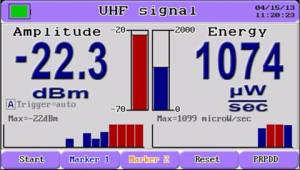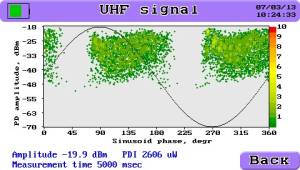DKL-3 – System for Periodic Condition Monitoring of High-Voltage Joints and Cables

The most common operational problem of high-voltage cables with cross-linked polyethylene insulation (XLPE) are defects in the insulation of termination and joints. That is the most often reason of "old" and relatively new cables' failure. Insulation condition monitoring of high-voltage XLPE cables becomes critical towards the end of cables life.
Development of defects in XLPE insulation, especially in joints, usually progresses quite fast. Therefore the periodic off-line tests which are effective for oil-paper insulation don't provide reliable operation of modern cables.
The most effective monitoring of XLPE cables condition is by using on-line monitoring systems, but such systems are economically justified only for the most expensive and important cables. The only reason is the high cost of stationary monitoring systems.
In practice, the more appropriate way is using cables condition periodic monitoring systems. Such systems apply the technology enabling secure measuring of the monitored cable parameters at any time. For this purpose, only primary sensors are installed fixed, but all the measurements are made by portable diagnostic devices and systems.
«DKL-3» system is used for cables joints periodic monitoring

«DKL-3» system has three main elements:
- "DKL-RFCT" is a set of the sensors and a switching box for connecting the portable device to the sensors. «RFCT-7» sensors («RFCT-4» sensors are used for the most powerful cables) are mounted on the grounding conductor of cable shield or a joint. Then the cables from the sensors are output to the switching box and connected to a the printedcircuit board (PCB). Any measuring devices can be connected to the slots of this PCB.
- "Dim-LOC" is a portable device for PD measuring and analysis in the joints and cables insulation. This compact device measures PD in the insulation. Measurements can be in any of the three frequency ranges: Acoustic, High Frequency (HF) or Ultra High Frequency (UHF). It allows monitoring joints and high-voltage cable condition.
- «iNVA» is a PC database and expert software for cables condition monitoring and forecasting of expected cable life.
PD Measurements in cables by «DIM-Loc» device
«DIM-Loc» device is a multipurpose PD measuring device, the most effective in high-voltage cables condition monitoring.
When XLPE cables insulation condition monitoring is being carried out, the partial discharges must be measured in a wide frequency range from fractions of a MHz and up to GHz. This is the precondition for of cables and joints insulation condition complex monitoring.
PD pulses of XLPE insulation are high frequency at first stage. As they move through the cables, they change their character: they decrease in amplitude and wide in duration.
If a pulse is in joint near the sensor, then its frequency will be high equal to hundreds of MHz. Therefore discharges in joints are measured in UHF range. If the pulse occurs at a considerable distance from the sensor, its frequency may be "only" hundreds of kHz. The longer is the cable, the lower frequency PD pulses can be measured in it. Therefore HF range sensors are used for cables insulation monitoring.
HF or UHF sensors are used with «DIM-Loc» device depending on the monitoring purpose. HFrange sensors (RFCT) are fixed on shield grounding conductors. UHF range sensors are wideband electromagnetic antennas used for remote measurement of PD cables insulation.
Partial discharges in terminal and joints can also be monitored by acoustic sensors of up to 100 kHz frequency range. The sensors can be contact and contactless, and both the types are available with «DIM-Loc» device set.
Diagnostic capabilities of «DIM-Loc» device for periodic monitoring

«DIM-Loc» device allows:
- PD measuring in the insulation of cables, terminal and coupling joints by using UHF, HF and acoustic sensors.
- PD measuring in UHF range in two ways: using the full range of frequencies and by separating the full range into narrow 10 ? 20 MHz bands.
- PD measuring in joints by contact and contactless acoustic sensors.
- cable defects locating by using HF sensors and the device: by making the on-line reflectogramm of the cables; the type of this reflectogramm corresponds to the PD pulse distribution along the cable;
- watching PRPD pulse distribution in the screen and identifying the defect type in the cables insulation.

Thus the periodic monitoring device can solve all on-line diagnostics problems and evaluate the cable condition.
After partial discharge measured and processed, the following information is available:
- joint insulation condition;
- cable section condition;
- insulation defect type;
- the defect location.
«DKL-3» system delivery set
The standard set of «DKL-3» monitoring system for periodic monitoring of high-voltage cables and joints includes:
- «DIM-Loc» device - 1 piece.
- Three-phase sets of «DKL-RFCT» sensors with the switching box for required number of monitored cables and joints.
- «iNVA» PC software for periodic monitoring and expert diagnostic.
- Documentation on a CD.
Any additional PD sensors for «DIM-Loc» device, such as remote acoustic sensor, high-frequency clump meters, different antennas, etc. are available on request.
Periodic monitoring
Periodic monitoring of high-voltage cables with «DKL-3» system requires:
- Installing a set of sensors with «DKL-3» devices on each monitored cable. A single set of sensors on one end is sufficient for cables up to 100 meters long. Longer cables require sensors on their both ends. If the cable is longer than 500 meters, the set of sensors on every joint is desirable.
- Preliminary calibration of all the installed sensors by HF test-pulse generator for more accurate PD measurements;
- Measuring partial discharges in cables and joints at least once in three months. On-line diagnostics of insulation are done on-site, and more detailed diagnostics are made after the information from the device is downloaded to the software for periodic monitoring;
- More accurate PD measurement requires calibrating all installed sensors by using highfrequency pulses calibration generator.
«DIM-Loc» Device and «DKL-RFCT» Sensor Set Specifications
| Cables rated voltage, kV | 6 ÷ 500 |
| Type of insulation condition monitoring | PD monitoring |
| Length of Monitored cables, m | up to 10,000 |
| HF PD Measuring Range, МHz | 0,5 ÷ 20,0 |
| UHF PD Measuring Range, МHz | 200,0 ÷ 1000,0 |
| HF amplitude of high-frequency pulses, mW | 20,0 ÷ 100000,0 |
| UHF amplitude of high-frequency pulses, dBm | -70,0 ÷ -25,0 |
| Acoustic channel range, kHz | 30,0 ÷ 300,0 |
| SCADA connection interface | USB |
| Sensors temperature range, °C | -40 ÷ +60 |
| Device temperature range, °C | -20 ÷ +60 |
| Dimensions, mm | 230 * 170 * 40 |




